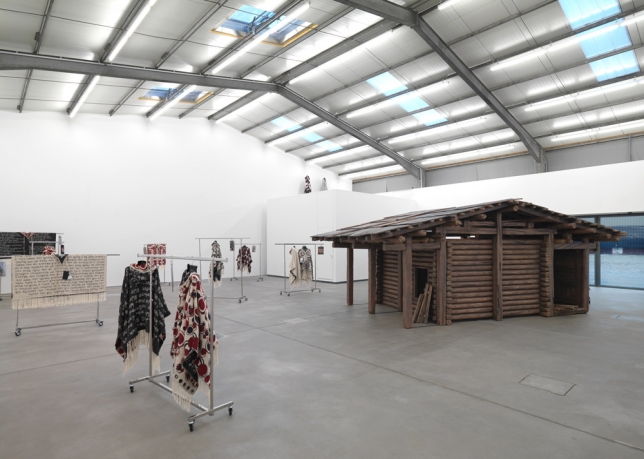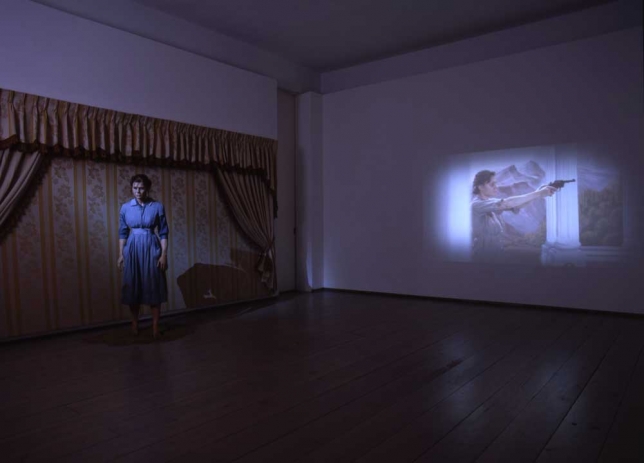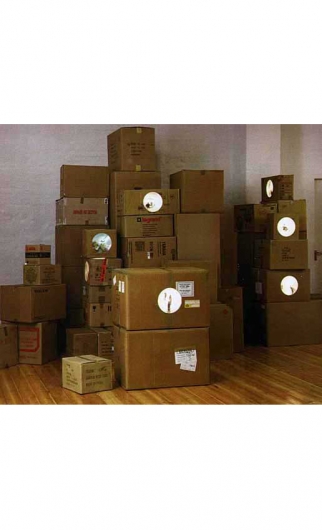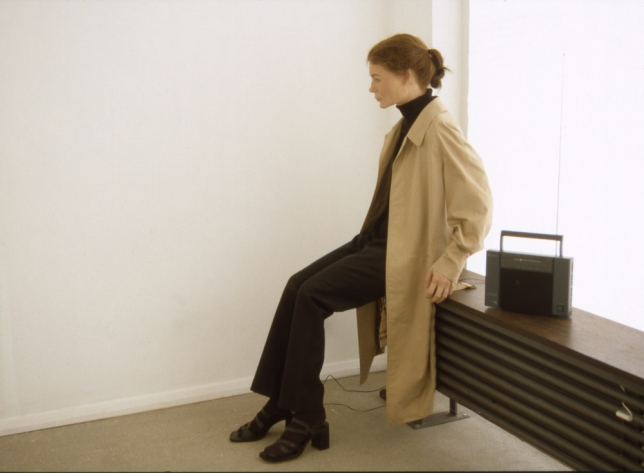28.02.–11.04.09
Mathilde ter Heijne
"Red, Black, Silver and White"
Solo exhibition at Arndt & Partner, Berlin
Mathilde ter Heijne
born in 1969 in Strasbourg, France
lives and works in Berlin
The works of the artist are predominantly produced in series, although they encompass a broad spectrum of different media such as sculpture, video, books, installations and often share a common theme. Over the past years ter Heijne has focused on the research of matriarchal societies and on the decoding of prehistoric symbol systems. Her recent installation “Export Matriarchy” (2007), for example, consists of a 200-year-old traditional replica Mosuo house, reduced in scale and made of polyurethane. The Mosuo are a matriarchal people residing in the Yunnan province of southern China. The social order of the Mosuo is characterized to this day by genuine equality of the sexes and women’s right to choose their own partners, as well as by the absence of marriage, the nuclear family, private property and class differences. In the life of the Mosuo the house plays a central role, not only as a habitat but as a symbol for social order and the community. In her comic book “The Empire of Women – Not a Fairytale” (2007), also part of the installation, the artist uses several different text and image levels to illustrate her journey with her team to the region where the Mosuo people live and we learn about how the artist acquired a wooden Mosuo house in order to exhibit it as “tribute to a dying culture” in the Beijing.
The Stedelijk Museum Bureau Amsterdam (2009), the Berlinische Galerie, Berlin (2006), the Götz collection, Munich (2005), and the Migros Museum für Gegenwartskunst, Zurich (2002), have dedicated comprehensive solo shows to her work. She has participated in numerous group shows such as “Female Trouble,” Pinakothek der Moderne, Munich, Germany (2008), “Made in Germany,” the Sprengel Museum, Kunstverein Hannover, and kestnergesellschaft, Hannover, Germany (2007), the 4th Seoul International Media Art Biennale, the Shanghai Biennale (both 2006), and “A Greater New York,” P.S.1 Contemporary Art Center, New York, 2005.
EXHIBITIONS:
29.4. - 30.5.2010
“Changing The World”
Group exhibition with works by
Erik Bulatov, Sophie Calle, William Cordova, Wim Delvoye, Anton Henning, Thomas Hirschhorn, Ilya und Emilia Kabakov, Jitish Kallat, Jon Kessler, Karsten Konrad, Julije Knifer, Enrique Martinez Celaya, Josephine Meckseper, Vik Muniz, Muntean Rosenblum, Julian Rosefeldt, Charles Sandison, Dennis Scholl, Nedko Solakov, Hiroshi Sugito, Ena Swansea, Mathilde Ter Heijne, Keith Tyson, Ralf Ziervogel
at ARNDT Berlin
28.02.–11.04.09
Mathilde ter Heijne
“Red, Black, Silver and White”
Solo exhibition at Arndt & Partner, Berlin
28.11. – 27.01.07
Mathilde ter Heijne
“No Depression in Heaven”
Solo exhibition at Arndt & Partner, Berlin
15.11. – 10.1.04
“Silent Screams Difficult Dreams”
Group exhibition with works by
With works by Louise Bourgeois (F), Sophie Calle (F), Maria Marshall (GB), Mathilde ter Heijne (NL) and Susan Turcot (CAN),
at Arndt & Partner, Berlin
14.9.-26.10.2002
Mathilde ter Heijne
„Number One“
solo exhibition at Arndt & Partner, Berlin
15.04. – 03.06. 2000
Mathilde ter Heijne
„Mathilde, Mathilde...“
Solo exhibition at Arndt & Partner, Berlin
17.07. - 04.09.1999
Group exhibition with works by
Thomas Hirschhorn (CH), Mathilde ter Heijne (NL), Susan Turcot (D/K), Via Lewandowsky (D)
at Arndt & Partner, Berlin
30.10 - 14.11.1998
Mathilde Ter Heijne
„Life inside storage“
at Arndt & Partner, Berlin
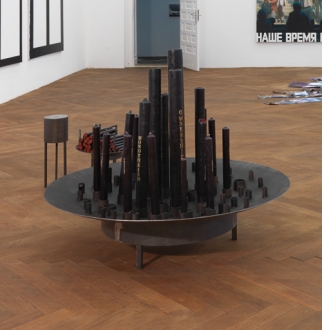 Mathilde ter Heijne, Send it back to where it came from, 2010, interactive sculpture/installation with magical reverse candles, 39.37 x 59.06 x 59.06 in, Edition of 2 + 1AP
Mathilde ter Heijne, Send it back to where it came from, 2010, interactive sculpture/installation with magical reverse candles, 39.37 x 59.06 x 59.06 in, Edition of 2 + 1AP Mathilde ter Heijne - Any Day Now - solo show at Kunsthalle Nürnberg
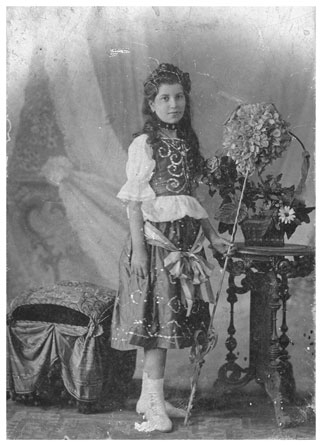 Mathilde ter Heijne, Postcard detail from "Woman to go", 2005
Mathilde ter Heijne, Postcard detail from "Woman to go", 2005
 Mathilde ter Heijne, Mathilde ter Heijne, exhibition view "Any Day Now" - single show at Kunsthalle Nürnberg
Mathilde ter Heijne, Mathilde ter Heijne, exhibition view "Any Day Now" - single show at Kunsthalle Nürnberg
 Mathilde ter Heijne, Mathilde ter Heijne, Mathilde ter Heijne, exhibition view "Any Day Now" - single show at Kunsthalle Nürnberg
Mathilde ter Heijne, Mathilde ter Heijne, Mathilde ter Heijne, exhibition view "Any Day Now" - single show at Kunsthalle Nürnberg
 Mathilde ter Heijne, Mathilde ter Heijne, Mathilde ter Heijne, exhibition view "Any Day Now" - single show at Kunsthalle Nürnberg
Mathilde ter Heijne, Mathilde ter Heijne, Mathilde ter Heijne, exhibition view "Any Day Now" - single show at Kunsthalle Nürnberg
16. September bis 14. November 2010
Opening: Wednesday, 15 September, 8 pm
Greeting: Ellen Seifermann, Leiterin der Kunsthalle Nürnberg
Introduction: Dr. Harriet Zilch, Kuratorin der Ausstellung
Performance of Mathilde ter Heijne and Jen Ray
The survey exhibition Mathilde ter Heijne. Any Day Now, which has been conceived in close cooperation with
the artist, presents a diverse selection of works from the past twelve years.
The exhibition will be accompanied by an artist’s book (104 pages, German/English, Verlag für moderne Kunst
Nürnberg). In addition to reproductions of the works and extensive source material, the catalogue comprises
interviews with Mathilde ter Heijne and introductory texts to the artist’s themes. The exhibition and artist’s
book have been produced in cooperation with LENTOS Kunstmuseum Linz. The exhibition – with a distinctive
selection of works – will be shown in Linz from 21st January to 27th March 2011.
Olacak - a project by Mathilde ter Heijne and Kartal Women's Products Market
 Mathilde ter Heijne, Olacak a project by Mathilde ter Heijne and Kartal Women's Products Market
Mathilde ter Heijne, Olacak a project by Mathilde ter Heijne and Kartal Women's Products Market
Opening: Wednesday, July 14 - 18:00 ( At 19.00 Monika Bulanda will sing 'Snake Power')
Mathilde ter Heijne internationally renowned for her confrontative multi-media installations is presenting her latest project developed during her stay at Platform Garanti Contemporary Art Center Istanbul Residency Program.
Pursuing her interest in exploring the image of women in society, the artist was drawn to the 'Women's Products Market' organized by the not-profit organization Foundation for the Support of Women's Work (FSWW) and Kartal Municipality, which recently opened in the district of Kartal and where local women sell their handcrafted products. Ter Heijne gave each of the women a piece of fabric and asked them to apply their skills and express their dreams, hopes, or frustration. Each piece was to become the segment of a snake.
In Christian culture the snake is the symbol of the inferiority of women, which is exactly why Ter Heijne chose it as the symbol of empowerment for the women of Kartal. Initially the women were a little skeptical, but as they started grasping that this snake stood for networking, for helping and supporting each other, more and more women wanted to participate. Currently the snake is about 25 meters long.On the 18th of June, the women paraded their snake in Kartal, from where they took the train and boat to Beyoğlu and ended their walk at DEPO, Tophane.
Ter Heijne asked the women a lot of questions about themselves. Their answers have been turned into a rap song by musician and rap singer Monika Bulanda whose song ‘Snake Power’ accompanied the snake walk acoustically. The snake and the song will be on display at DEPO between the 14th and 24th of July.
Mathilde ter Heijne - Any Day Now - solo show at LENTOS Kunstmuseum Linz, Austria
21 January - 27 March 2011
LENTOS Kunstmuseum Linz
Ernst-Koref-Promenade 1
4020 Linz, Austria
The survey exhibition Mathilde ter Heijne. Any Day Now, which has been conceived in close cooperation with
the artist, presents a diverse selection of works from the past twelve years.
The exhibition will be accompanied by an artist’s book (104 pages, German/English, Verlag für moderne Kunst
Nürnberg). In addition to reproductions of the works and extensive source material, the catalogue comprises
interviews with Mathilde ter Heijne and introductory texts to the artist’s themes. The exhibition and artist’s
book have been produced in cooperation with Kunsthalle Nürenberg.
Exhibitions
PRESS RELEASE
In her fifth solo exhibition at Arndt & Partner Berlin, Mathilde ter Heijne is showing the first collection of her recently founded Goddess Label as well as an installation based on her project Mosuo Fireplace Goddess that was produced in China two years ago.
The works of the artist are predominantly produced in series, although they encompass a broad spectrum of different media such as video, books, installations and, most recently, clothing. The works presented at Arndt & Partner, too, share a common theme. They have arisen from the artist’s research over the past three years on matriarchal societies and on the decoding of prehistoric symbol systems. The works explore the role of women in shaping cultural identity and in the transfer of knowledge within societies with a matriarchal structure. The focal point of ter Heijne’s research is the archeological assumption that the cultures of the Neolithic period , in contrast to the religions codified on alphabetic scripts – Judaism, Christianity and Islam – did not believe in a male creator; instead they worshiped an array of female goddesses. While it can be assumed that the invention of the Sumerian script and the emergence of the “religions of the book” served as catalysts in the formation of patriarchal social orders , it has been proven that in the preceding Neolithic era matrilineal cultures existed. It is this correlation between religion, script or symbol systems and gender roles that the artist is particularly interested in.
Ter Heijne’s installation Export Matriarchy (2007) consists of a replica house, reduced in scale and made of polyurethane so that it can be assembled easily, of a 200-year-old traditional dwelling that the artist purchased from a Mosuo family in 2007. The Mosuo are a matriarchal people residing in the Yunnan province of southern China. The social order of the Mosuo is characterized to this day by genuine equality of the sexes and women’s right to choose their own partners, as well as by the absence of marriage, the nuclear family, private property and class differences. In the life of the Mosuo the house plays a central role, not only as a habitat but also as a sacred place for worshipping the goddesses, and as a symbol for social order and the community.
Ter Heijne is also presenting her comic The Empire of Women – Not a Fairytale (2007) at Arndt & Partner. The comic – free copies of which are available to visitors – uses several different text and image levels to illustrate the artist’s journey with her team to the Lugu sea, the region where the Mosuo people live. Through diary entries, descriptions of the daily lives of the Mosuo, and conversations with members of the tribe we learn about how the artist acquired the wooden Mosuo house in order to exhibit it as “tribute to a dying culture” in the Beijing gallery Currents.
The installation Red, Black, Silver and White (2009) belongs to ter Heijne’s most recent body of works. Nine different ponchos, created in collaboration with the Berlin fashion label von Wedel & Tiedeken, are presented on clothes rails. They represent the first collection of the artist’s recently founded label Goddess. The ponchos, which are made of the finest cotton and baby-alpaca wool inspire associations with warmth and protection – perfect in times of crisis. At the same time, the ponchos serve as an exclusive medium for specific messages: the geometric patterns on the outside refer to the Eastern European symbol system of an era that preceded the emergence of the Sumerian script. The system was deciphered by the prehistorian Marija Gimbutas (1921–1994), who succeeded in proving that the Neolithic symbols testify to the dominant status of goddesses over male gods and to the existence of societies with matrilineal social structures. Inside, the ponchos are decorated with texts intended to protect and empower the person wearing them. They are written in Pictish, an extinct script from the Middle Ages in what was later to become northern and eastern Scotland and which was used again in the 19th century by adherents of a neo-pagan cult in order to transfer secret knowledge between insiders. By means of a decoder attached to the poncho’s label the viewer is able to read the Pictish texts.
Born in 1969 in Strasbourg, France, Mathilde ter Heijne studied at the Stadsacademie, Maastricht and the Rijksacademie, Amsterdam. From 2004 to 2005 she lived in New York on a P.S.1 studio grant financed by the Berlin Senate. She now lives and works in Berlin. She has presented numerous solo exhibitions at international institutions such as Currents, Beijing (2007), the Berlinische Galerie, Berlin (2006), and the Migros Museum für Gegenwartskunst, Zurich (2005). Group exhibitions she has participated in include Female Trouble (Pinakothek der Moderne, Munich, 2008), Made in Germany (Sprengel Museum Hannover, kestnergesellschaft, and Kunstverein Hannover, 2007), the 4th Seoul International Media Art Biennale, Shanghai Biennale (both 2006), and A Greater New York (P.S.1 Contemporary Art Center, New York, 2005). Currently her works are on view in the exhibition See History 2008 at the Kunsthalle zu Kiel, Germany (until July 20, 2009).
28.11. – 27.01.07
Mathilde ter Heijne
“No Depression in Heaven”
Solo exhibition at Arndt & Partner, Berlin
PRESS RELEASE
We are pleased to present the third solo show of Mathilde ter Heijne at Arndt & Partnre, Berlin. The artist is showing recent installations as well as a new video piece.
Like a red thread the theme of invisible power structures and of personal as well as political violence weaves through her work. Recurrently the artist depicts aspects of intimate, religious, and national conflict or (auto) aggressive reactions to the cultural and gender-specific allotment of roles.
The title of the installation "Women to go" (2005) invites the observer to take one of the array of 320 postcards for free. The photographs show unknown women from around the world from the period between 1800 and 1900. Written on the backs of the postcards are real biographies of women from the same period, but from different cultural backgrounds, who came to public attention for their exceptional lives or achievements - for example the first female university graduates, lawyers, artists, freedom fighters or scientists - but whose lives often had a tragic end and, with the passage of time, were forgotten. With her meticulous research Mathilde ter Heijne has pursued a critical examination of the genre of female biography and the way it functions. In formal terms this piece - as often occurs in the artist's work - acts within that area of tension existing between fiction and documentation and the divergent interplay of image and text.
Mathilde ter Heijne continues to explore her concern with media constructs in the video essay "No depression in heaven" (2006). She employs the special effect of Matte Painting on glass in order to show the construction behind the illusion and in order to combine painting and film. The models for the painted foregrounds and backgrounds on glass and canvas are the documentary photographs which Walker Evans made during the Depression years in the United States. The video narrative reflecting on the class conflict between rich and poor is accompanied by the melancholic song "Oh Death" by Sarah O. Cunning - folk singer and voice of the American workers' movement of the period. The double female role in this video is also an ironic reference to the genre Women's Film, which was successful in the 1930s in Hollywood cinemas. These films usually dealt with the moral conflict between women's real and fantasised self-image and the resulting split of the female self into two paradoxical identities.
Another recent work by Mathilde ter Heijne - a life-size bronze of a female figure - ties in with her research on the subject of (self )sacrifice and its religious and cultural backgrounds, in which she deals with the myth of matriarchal pre-history. Mathilde ter Heijne, born in Strasbourg in 1969, lives and works in Berlin. The Berlinische Galerie, Berlin (2006), the Götz collection, Munich (2005), and the Migros Museum für Gegenwartskunst, Zurich (2002), have dedicated comprehensive solo shows to her work. She has participated in numerous group shows at venues such as the Shanghai Art Biennial (2006), the P.S.1, New York (2005), and the Neue Galerie Landesmuseum Joanneum, Graz, Austria (2003). Next year she will present her works in the exhibition "Romantic Conceptualism" at the American Federation of Arts in New York.
14.9.-26.10.2002
Mathilde ter Heijne (NL)
„Number One“
Solo exhibtion at Arndt & Partner, Berlin
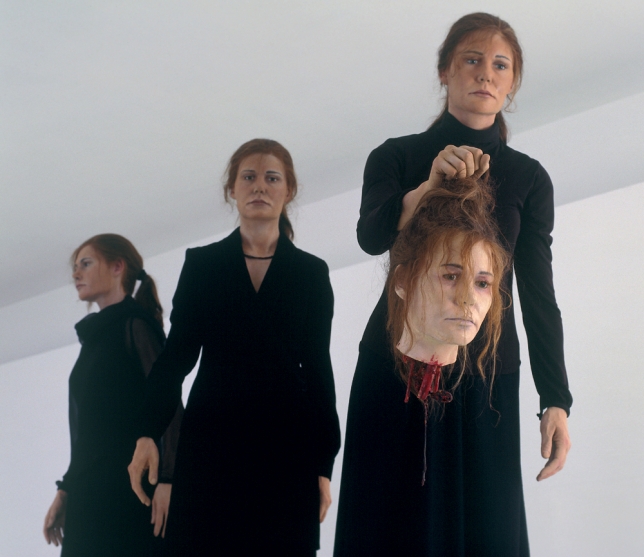 Mathilde ter Heijne, "Number One“, solo exhibtion at Arndt & Partner, Berlin (Image: Menschenopfern)
Mathilde ter Heijne, "Number One“, solo exhibtion at Arndt & Partner, Berlin (Image: Menschenopfern) PRESS RELEASE
Mathilde ter Heijne’s concern for topics of political violence and power-relationships within society and her related questioning of her role as an artist are central aspects of her oeuvre. In particular, the phenomena of victimisation, self-sacrifice and self–immolation, which condition our existence as political and private human beings, have been subject to her repeated investigation.
The exhibition ‘Number One’ closely relates to these issues. Her latest installation ‘Menschen Opfern’ (sacrifycing humans) confronts the visitor upon entry: five figures, all doubles of the artist herself, are grouped on a platform. The scenario of mutilated bodies bears connotations with ritualistic
sacrifices of human beings as practised in Ancient Greece, or possibly a Greek theatre stage on which these rituals were ‘reenacted’ as tragedies.
In fact, the scene is based on the Greek tragedy ‘Iphigenia on Tauris’ by the dramatist Euripides (ca. 450 B.C.). Faced with the threat of being sacrificed by her father Agamemnon to appease the goddess Artemis, the character of Iphigenia has not only become a symbol of victimisation within a patriarchal society; as Iphigenia is rescued by Artemis herself to become one of her priestesses, she also personifies the emancipation from male dominance. Based on the composer Christoph Willibald Gluck‘s opera ‘Iphigénie en Tauride’ (1779), ter Heijne herself is recorded singing the chorus of Diana‘s priestesses, in which they ask for the goddess’ forgiveness.
The tension inherent in ter Heijne’s prominent use of the double, as already employed in earlier installations, such as ‘Mathilde, Mathilde…’ (2000) or ‘Suicide Bomb’ (2000), clearly reaches its climax in this work. The double does not only reveal the simultaneous identification with and rejection of the role of the victim, but also displays the fictitious character of the scenery. The artist’s failure of full identification and the shift of pain onto the double convey ter Heijne’s artistic strategy of self-questioning, not only in her role as an artist, but also in her social, political and private role as a woman.
Her video installation, ‘Small things end, great things endure’ (2001) likewise centres around the
motif of victimisation and self-immolation. Once more, the heroine is based on a fictitious character: Gesine Cresspahl, the main protagonist of Uwe Johnsen‘s novel ‘Jahrestage’ (1934–84). While the novel tells the life story of Gesine’s mother, who – guilt ridden by the atrocities of the National Socialist Regime – decides to atone for this by burning herself, ter Heijne has modified the ending of the story: she projects the mother’s decision onto Gesine, who, facing the same unbearable feelings of guilt in the light of the Vietnam war during the 1960s, decides to set fire to herself at her home in Mecklenburg. In a loop, the video depicts the act of self-immolation, with the artist herself as Gesine Gresspahl. A female voice, from Magarethe von Trotta’s film version of the novel, cites the protagonist‘s quest for forgiveness, while a male voice recites a passage of Johnson’s book, passionlessly describing the detected scenery after Gesine’s death. In line with her
earlier installation ‘For a better world’ (2000), dealing with the phenomenon of self-immolation as a political act, this work seems more intimate and less detached. Once more, her delegating the role of the victim – this time, onto a fictitious character – and exploring the issue of self-immolation as a moral and ideological act, reveals her quest for unravelling the complexity of power-relationships that condition our political and personal reality.
Born in 1969 in Strasbourg, France, Mathilde ter Heijne has studied at the City Academy in Maastricht and lives and works in Berlin. After various successful exhibitions in Europe and the US, she has recently had a solo show at the migros museum für gegenwartskunst in Zurich. ‘Number One’ is Mathilde ter Heijne’s second solo exhibition at Arndt & Partner .
30.10 - 14.11.1998
Mathilde Ter Heijne (NL)
„Life inside storage“
Solo exhibition at Arndt & Partner, Berlin
15.04. – 03.06. 2000
Mathilde ter Heijne (NL)
„Mathilde, Mathilde...“
solo exhibition at Arndt & Partner, Berlin
17.07. - 04.09.1999
Thomas Hirschhorn (CH), Mathilde ter Heijne (NL), Susan Turcot (D/K), Via Lewandowsky (D)
Group exhibition at Arndt & Partner, Berlin
